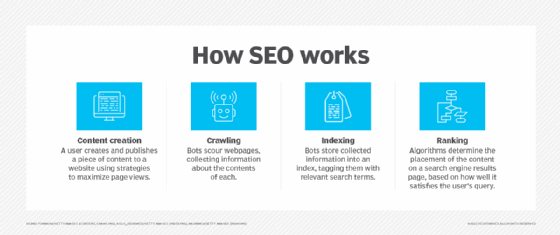cloaking
What is cloaking in SEO?
Cloaking is a technique where a different version of web content is returned to users than to the search engine crawlers. This technique might be used for search engine optimization (SEO) to move a page up in search engine rankings by exposing a version of the page to search engine bots that satisfies criteria needed to increase ranking while displaying different content to users.

Cloaking is one of many types of black hat SEO, a set of techniques designed to exploit weaknesses in search engines. Other forms of black hat SEO include the following:
- Keyword stuffing. A page is filled with keywords in a meaningless fashion just to satisfy search criteria.
- Content automation. A step above keyword stuffing, content automation uses keywords but makes some attempt to provide meaningful content instead of just a page randomly filled with keywords.
- Sneaky redirect. The URL that's indexed by web crawlers in association with certain keywords is redirected to another page that has nothing to do with what the user was looking for.
Cloaking can also be used to hide illegal or undesirable content from web crawlers. For example, a website might hide pornographic content using this technique. Black hat hackers can also use cloaking to contaminate a computer through malicious content it returns to certain requestors.
A related technique called network cloaking is used to provide network security by hiding the network name of a device or service so that it can't be identified publicly.
Why should you avoid cloaking in SEO?
Cloaking, like all other black hat SEO techniques, violates search engine guidelines, including Google's Webmaster Guidelines. If Google or any other major search engine detects that a site is using SEO cloaking techniques to fool the search engine into giving it a higher ranking, the search engine is likely to penalize the site by downgrading its ranking, banning the website or even removing it from the search engine index. Search engines update their algorithms frequently and use a variety of methods to detect cloaking.
For these reasons, SEO cloaking isn't a good practice for long-term business success. It might wind up lowering a site's ranking rather than raising it. It's also likely to frustrate users by returning unwanted content. Over time, the practice negatively affects the image of the company in the marketplace.
How can you tell if a website is using cloaking?
There are several ways for a webmaster to determine if a website is using cloaking. For example, they can compare the search engine results page result to the actual web page. The text snippet a Google search provides based on the search term will be in bold, and the text from the web page searched should match this text.
There are also online site checking tools, including Sitechecker, Small SEO Tools and DupliChecker. Although these tools offer paid plans, several provide a limited number of checks for free. These tools scan the page's URL to detect hidden scripts and other code issues and alert the user if the webpage is using cloaking.
Learn how analytics tools can provide content teams with insight into what their site visitors want.






